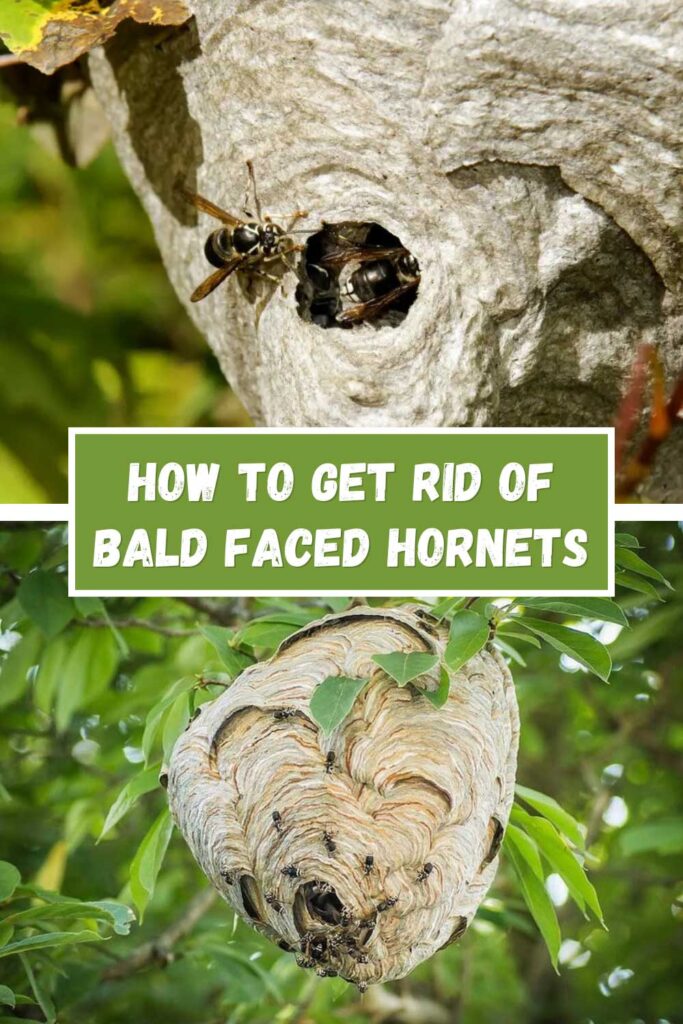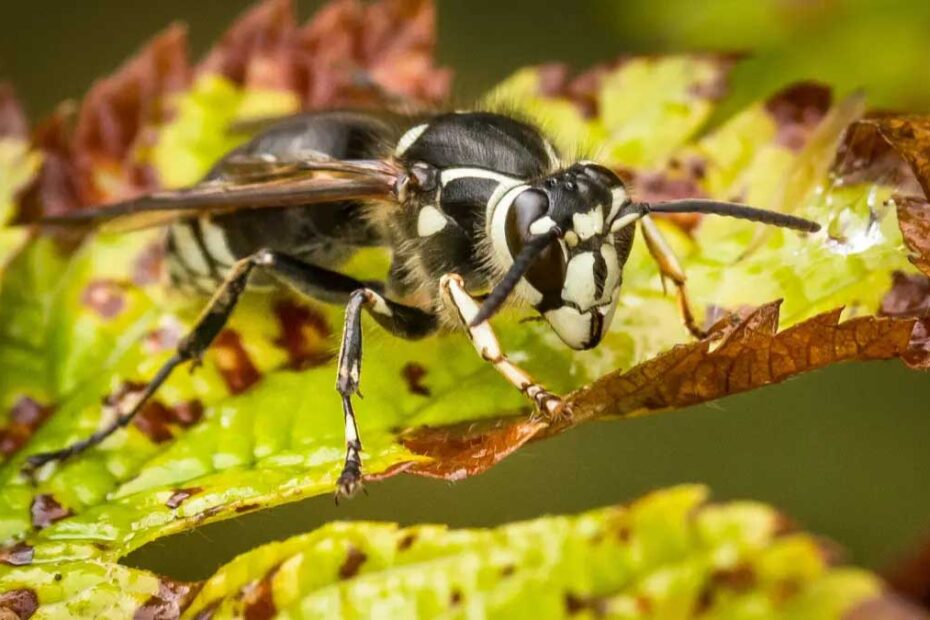Bald-faced hornets can turn your peaceful backyard into a nerve-wracking battleground. Known for their aggressive behavior and painful stings, these pests build large, football-shaped nests that can house hundreds of hornets. If you’ve noticed one of these nests hanging from a tree or under the eaves of your home, it’s crucial to act quickly.
Dealing with bald-faced hornets isn’t just about removing a nuisance; it’s about ensuring the safety of your family and pets. In this guide, you’ll learn effective methods to safely and efficiently get rid of these unwelcome guests. Whether you prefer DIY solutions or professional help, we’ve got you covered.
Key Takeaways
- Identification and Understanding: Bald-faced hornets are aggressive insects with distinct black and white markings, building large, aerial nests in trees, bushes, or under building eaves.
- Safety Risks: Their stings can cause serious health risks, especially for allergic individuals, and their nests can lead to property damage and disrupted outdoor activities.
- Early Detection: Identifying nests and hornet behaviors early, such as increased activity and specific nesting patterns, helps in effective management.
- Preventative Measures: Securing food sources, maintaining cleanliness, and performing regular property inspections can deter hornets from nesting around your home.
- Removal Methods: DIY solutions can work for small, accessible nests, but professional pest control is recommended for larger or hard-to-reach infestations for safety and effectiveness.
- Post-Removal Care: Ongoing vigilance, including monitoring for new nests and maintaining cleanliness, is crucial to prevent reinfestation and ensure a hornet-free environment.

Understanding Bald Faced Hornets
Bald-faced hornets, part of the Vespidae family, are known for their aggressive behavior and powerful stings. They play a role in ecosystems, yet pose risks in residential areas. Let’s break down key details about these insects.
Key Characteristics
Scientific Name
Dolichovespula maculata, the bald-faced hornet, is black with white or ivory markings primarily on the face and body.
Size
Adults measure between 1/2 inch and 5/8 inch long. Queens are slightly larger.
Nests
Their aerial nests, found in trees, bushes, or building eaves, are made from chewed wood fibers mixed with saliva, forming a gray, papery appearance.
Sting
Hornets are highly protective of their nests and possess the ability to sting multiple times. Their venom can cause pain, swelling, and allergic reactions.
Behavior and Habitat
Nesting Habits
Bald-faced hornets build large, football-shaped nests above ground. They prefer:
- Trees and shrubs (for concealment)
- Building eaves and overhangs (protection from elements)
- Attics and sheds (less disturbance)
Activity Patterns
Hornets are most active during the daytime:
- Foraging: They gather nectar and hunt insects.
- Nest Maintenance: Workers repair and expand nests.
- Defense: Guarding the nest against intruders.
Why They’re a Problem
These hornets can become aggressive when protecting their nests. Potential issues include:
- Safety Risks: Their stings can pose serious health risks, particularly for those with allergies.
- Property Damage: Nests built on structures can cause damage over time.
- Disruption: Their presence can disrupt outdoor activities.
Action Point
Understanding bald-faced hornet behavior and characteristics helps in identifying and managing these pests effectively. Identifying their nests early and considering professional assistance for safe removal can mitigate risks.
Signs Of Infestation
Identifying a bald-faced hornet infestation early helps prevent potential threats. You’ll notice several specific signs indicating their presence.
Nests
Bald-faced hornets build large, aerial nests:
- Made from chewed wood fibers.
- Often found in trees, bushes, or under building eaves.
- Gray with a papery texture, resembling a rough football in shape.
- Can reach up to 24 inches in circumference.
Activity Patterns
Hornets exhibit noticeable behaviors:
- Increased hornet activity around your property or garden.
- Constantly coming and going from a particular area.
- Aggressive when approached near nesting sites.
Physical Appearance
Recognizing the hornets can confirm an infestation:
- Black bodies with white facial markings.
- Measuring between 1/2 inch and 5/8 inch long, with larger queens.
- Active throughout the day, particularly in early morning and late afternoon.
If you observe these signs, consider taking action to address the infestation. Identifying nests and hornet behaviors early allows you to choose effective methods for removal, ensuring your safety.
Preventative Measures
Taking preventive measures is crucial to avoid dealing with bald-faced hornet infestations. Implementing these steps can help deter hornets from nesting in or around your property.
Secure Food Sources
Bald-faced hornets are attracted to food sources that are easily accessible.
- Garbage Cans: Ensure garbage cans have tight lids. Rinse containers before disposal to minimize food residue.
- Pet Food: Avoid leaving pet food outdoors. Bring it inside after feeding or store it in sealed containers.
- Compost Bins: Use compost bins with tight-fitting lids. Turn the compost regularly to reduce odors.
- Fruit Trees: Remove fallen fruit from your yard daily. Overripe fruit can attract hornets.
Maintain Cleanliness
Consistent cleanliness around your property can further discourage hornets from settling.
- Yard Maintenance: Regularly mow your lawn and trim bushes. Clear away debris, such as fallen leaves or twigs, that can provide shelter.
- Building Maintenance: Seal cracks and gaps in structures. Repair window screens and damaged siding.
- Outdoor Dining Areas: Clean outdoor dining and barbecue areas immediately after use. Wipe down surfaces and store food promptly.
- Flowering Plants: Be mindful of planting fragrant flowers near entryways. If you do, regularly inspect these areas for hornet activity.
By securing food sources and maintaining cleanliness, you can effectively reduce the risk of bald-faced hornet infestations. Carry out these preventative measures consistently for the best results.
Removal Methods
Addressing a bald-faced hornet infestation requires careful planning and execution. Depending on the severity and location of the nest, you can choose between DIY methods and professional help. Each approach comes with specific safety precautions to minimize risk.
DIY Solutions
DIY solutions can be effective when the nest is small or easily accessible. Follow these steps for safe removal:
- Locate the Nest: Ensure the nest is easily accessible and not too high up.
- Protective Gear: Wear protective clothing, including gloves and a face mask.
- Insecticide Spray: Use a commercial hornet spray designed for wasps and hornets. Apply it during the evening for best results.
- Remove the Nest: Wait 24 hours after spraying. If thereâs no activity, carefully remove the nest using a plastic bag.
- Dispose Safely: Seal the nest in the bag and dispose of it securely away from your property.
Professional Pest Control
Professional pest control is recommended for large or hard-to-reach nests. Benefits include:
- Expertise: Licensed professionals have extensive knowledge about hornet behavior and nest removal techniques.
- Safety: Professionals use advanced equipment and protective gear, reducing the risk of stings.
- Effectiveness: Comprehensive treatment ensures that all hornets are eradicated, preventing future infestations.
- Timing: Perform removal activities during late evening or early morning when hornets are less active.
- Distance: Keep a safe distance from the nest during and after treatment.
- Protective Gear: Always wear protective clothing to prevent stings.
- Escape Plan: Have an exit route planned in case hornets become aggressive.
Post-Removal Care
After successfully removing a bald-faced hornet nest, ongoing vigilance ensures these pests don’t return. Implementing post-removal strategies safeguards your home and maintains a hornet-free environment.
Monitoring For New Nests
Consistent monitoring detects any new hornet nests early. Regularly inspect common nesting sites like trees, bushes, and building eaves. Look for:
- Hornet Activity: Increased hornet presence often signals new nest construction nearby.
- New Nest Formation: Spotting the beginning of a new nest allows for early intervention.
- Larvae and Adult Hornets: Both indicators of a developing nest.
If you spot these signs, take action immediately to remove nests before they grow.
Preventing Reinfestation
Preventative measures minimize the risk of reinfestation. Follow these steps to keep hornets away:
- Seal Entry Points: Close gaps in walls, eaves, and other structures.
- Secure Food Sources: Ensure garbage cans have tight lids, remove ripe fruits, and avoid leaving pet food outside.
- Maintain Cleanliness: Regularly clean yard debris, prune trees and bushes, and keep the property clean.
These steps create an inhospitable environment for hornets and reduce the chance of future infestations.
Conclusion
Addressing bald-faced hornets requires a proactive approach to ensure your family’s safety and protect your property. By understanding their behavior and identifying signs of infestation early, you can take timely action. Whether you opt for DIY methods or professional assistance, careful planning and execution are key to effective removal.
Preventative measures and ongoing vigilance are crucial in keeping these aggressive insects at bay. Secure food sources, maintain cleanliness, and regularly inspect your property for new nests. By implementing these strategies, you can create a hornet-free environment and enjoy peace of mind.
Frequently Asked Questions
What are bald-faced hornets?
Bald-faced hornets, scientifically known as Dolichovespula maculata, are aggressive insects with painful stings. They are black with white markings and range from 1/2 inch to 5/8 inch long, with queens being slightly larger.
Why is it important to remove bald-faced hornet nests from residential areas?
Removing bald-faced hornet nests is crucial to protect your family and pets from painful stings and potential allergic reactions. Their aggressive behavior and ability to sting repeatedly can pose significant safety risks.
How can I identify a bald-faced hornet infestation?
Look for large, gray, papery nests resembling rough footballs. Other signs include increased hornet activity around your property and the hornets’ distinctive black bodies with white facial markings.
What are some DIY methods for removing bald-faced hornets?
DIY methods include locating the nest, wearing protective gear, using insecticide spray during the evening when hornets are less active, and safely disposing of the nest after ensuring no hornet activity.
When should I consider professional pest control for hornet removal?
Consider professional pest control for larger or hard-to-reach nests. Professionals have the expertise, safety measures, and effective methods to eradicate hornets without risking personal injury.
What preventative measures can I take to avoid a hornet infestation?
Secure food sources by ensuring garbage cans have tight lids, avoid leaving pet food outside, and remove fallen fruit from yards. Maintain cleanliness around the property, including yard maintenance and sealing cracks in structures.
How can I effectively monitor for new hornet nests after removal?
Consistently inspect common nesting sites and look for signs of hornet activity, new nest formation, and larvae. Ongoing vigilance and maintenance can help prevent reinfestation.
What should I do if I encounter a bald-faced hornet nest?
Keep a safe distance, avoid sudden movements, and consider professional help if the nest is large or difficult to reach. If using DIY methods, perform removal activities during late evening or early morning when hornets are less active.
How can I secure entry points to prevent hornets from returning?
Seal any cracks or openings in your home’s exterior, including windows, doors, and vents. Regularly inspect these areas to ensure they remain secure against hornet entry.
Why are hornets more aggressive when defending their nests?
Hornets are highly protective of their nests and will aggressively defend them against perceived threats, posing a higher risk of stings and aggressive behavior.
